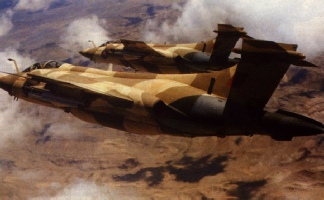


Red Flag ‘77 -
…... tended to loosen straps in order to monitor the visual threat envelope from high to low and, with considerable effort, the rear sector from two o’clock through to ten o’clock. Excellent lookout was imperative in such a clear air mass with few places to hide. If the pilot had to look into the cockpit, he warned the navigator to look ahead. At no time could both heads be diverted from the forward sector. This lesson was very quickly leamed by one of the experienced crews, who discovered this when they had a momentary lapse of concentration as they cleared the target area and were decelerating to re-
Speed was essential to aid manoeuvre, to pass through the threats quickly and to make enemy defence engagement solutions more difficult. Speeds were kept high as fuel was not in short supply, and the aircraft were carrying representative weapon war loads. Sorties were planned at 480 knots as ‘hostile’ territory was entered, and this was increased to 540 (nine nautical miles per minute) as the target area approached. Further knots could still be generated in extremis and for running out of the target area.
The Squadron always flew as constituted crews so that everyone was totally familiar with each other’s modus operandi and, for the same reason, everyone was teamed up with another crew to make a constituted pair and, further, joined with another pair as a constituted four-
always flew as constituted crews so that everyone was totally familiar with each other’s modus operandi and, for the same reason, everyone was teamed up with another crew to make a constituted pair and, further, joined with another pair as a constituted four-
At Goose Bay, the crews had learned to avoid wing flash when flying over the middle of plain ground features like lakes, dry or full, and to keep away from the valley floor by hugging the






